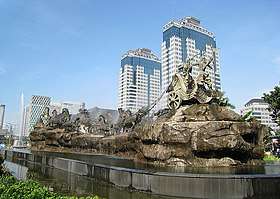Arjuna
Arjuna (Sanskrit: अर्जुन, IAST: Arjuna) is a protagonist of the Indian epic Mahabharata and also appears in other ancient Hindu mythological texts. In the epic he is described as one of the five sons of Pandu, collectively known as the Pandavas, and was born of a relationship between his mother, Kunti, and the god Indra. The family formed part of the royal line of the Kuru Kingdom.
| Arjuna | |
|---|---|
Statue of Arjuna, the skillful Pandava | |
| Devanagari | अर्जुन |
| Affiliation | Pandavas incarnation of Nara |
| Weapon | Bow and arrows |
| Battles | Kurukshetra War |
| Texts | Mahabharata |
| Personal information | |
| Parents | Pandu (Father) Kunti (Mother) Indra (Spiritual Father) |
| Siblings | Karna, Yudhisthira, Bhima, Nakula and Sahadeva |
| Spouse | Draupadi Ulupi Chitrāngadā Subhadra |
| Children | Shrutakarma (from Draupadi) Abhimanyu (from Subhadra) Iravan (from Ulupi) Babruvahana (from Chitrāngadā) |
| Dynasty | Kuru dynasty-Chandravanshi |
Arjuna is depicted as a skilled archer and wins the hand of Draupadi in marriage. She becomes his first wife and is simultaneously married to Arjuna's brothers. He is twice exiled, first for breaking a pact with his brothers; and secondly together with them when his oldest brother is tricked into gambling away the throne. One notable incident during the first exile was Arjuna's involvement in the burning of the Khandava Forest.
Etymology and epithets
The word Arjuna refers to the character having white skin and clean hands. He is known by many other names, such as:[1][2]
- Vijaya – always victorious, invincible and undefeatable
- Dhanañjaya – one who conquered wealth and gold
- Gudakesh - one who has conquered sleep
- Savyasachi – one who can shoot arrows with both hands
- Shvethavāhana – one with milky white horses mounted to his pure white chariot
- Anagha – one who is sinless
- Bībhatsu – one who always fights wars in a fair, stylish and terrific manner
- Kiriti – one who wears the celestial diadem presented by the King of Gods, Indra
- Jishnu – triumphant
- Phalguna – born under the star Uttara Phalguni (Denebola in Leo)
- Mahabahu – one with strong arms
- Gandivadhari – holder of a bow named Gandiva
- Pārtha – son of Pritha, also known as Kunti
Literary background
The story of Arjuna is told in the Mahabharata, one of the Sanskrit epics from the Indian subcontinent. The work is written in Classical Sanskrit and is a composite work of revisions, editing and interpolations over many centuries. The oldest parts in the surviving version of the text probably date to about 400 BCE.[3]
The Mahabharata manuscripts exist in numerous versions, wherein the specifics and details of major characters and episodes vary, often significantly. Except for the sections containing the Bhagavad Gita which is remarkably consistent between the numerous manuscripts, the rest of the epic exists in many versions.[4] The differences between the Northern and Southern recensions are particularly significant, with the Southern manuscripts more profuse and longer. Scholars have attempted to construct a critical edition, relying mostly on a study of the "Bombay" edition, the "Poona" edition, the "Calcutta" edition and the "south Indian" editions of the manuscripts. The most accepted version is one prepared by scholars led by Vishnu Sukthankar at the Bhandarkar Oriental Research Institute, preserved at Kyoto University, Cambridge University and various Indian universities.[5]
Early life
Arjuna was one of the five Pandava brothers of royal lineage, whose collective name derives from their father and heir to the Lunar dynasty, Pandu. However, Pandu was under a curse whereby he would die if he had sexual relations with a woman and thus his sons were conceived by his two wives—Madri and Kunti— with others.[6] According to the legend, Arjuna was a demigod, being the product of a miraculous birth resulting from a relationship between Kunti and the god Indra.[7][8] Whilst the Devi Bhagavata epic records Arjuna as a reincarnation of a rishi called Nara, the Mahabharata makes no mention of this.[9]
Despite being the younger brother of Dhritarashtra, it was Pandu who succeeded their father as king of Bharata. This was because Dhritarashtra was blind, a disability which caused him to forfeit his right to the royal succession. Dhritarashtra fathered 100 sons, known as the Kaurava brothers, and ascended the throne on the death of Pandu.[10][11] The Pandava brothers were then brought up with their cousins, the Kauravas, and the education of all these boys was supervised by Bhishma.[12] Among their teachers was the brahmin warrior called Drona, who considered Arjuna to be his favourite.[13] According to Swami Parmeshwaranand, Arjuna was Drona's most accomplished pupil. He notes an incident where Drona deemed that out of all his students, none but Arjuna had the steadfast focus to shoot the eye of a bird on a tree using a bow and arrow, and that Drona was proven right.[14] However, George M. Williams considers another pupil, Karna, to have been as capable as Arjuna. Karna had been born to Kunti prior to her marriage with Pandu, conceived with Surya but then abandoned to be raised by a low-caste family. He was thus secretly a half-brother of Arjuna and contrasted with him by being dark-skinned and of low status. As the legend progresses, these classmates become enemies, with Karna and the Kauravas allying against Arjuna and his four brothers.[9]
Once Duryodhana and his maternal uncle Shakuni planned to burn Pandavas alive along with their mother Kunti. They built a palace out of lac in a village named Varanāvata. The Pandavas, though, managed to escape the house of lac with the help of Vidura through a secret tunnel.[15] In time, Dhritarashtra determined to avoid a rivalry developing for control of Hastinapur by splitting the kingdom, with half of it being left to his own eldest son, Duryodhana, and half to the eldest son of Pandu, Yudhishthira.[10][11]
Marriages
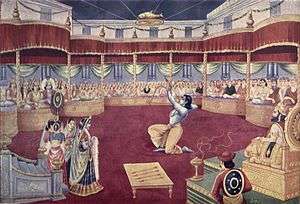
Arjuna is a central character in the Hindu epics and appears in hundreds of situations. Among the most notable is his marriage to Draupadi,[9][16] a daughter of Draupada, who was the king of Panchala.[17] Draupada holds an archery tournament to determine who should marry his daughter, whom all the Pandava brothers love, and this is won by Arjuna. Confusion arises when he runs home to tell his mother of his success, shouting "look what we have found". Commentators vary as to whether Kunti thought he was referring to alms found in the forest or to some great prize unknown to her. She tells him that the find must be shared with his brothers, as they had always shared such things in the past. This misunderstanding, combined with the protocol that the oldest of the brothers, Yudhishthira, should marry first, leads to agreement that all five brothers marry her. This is one of the rare examples of polyandry in Sanskrit literature.[9][18] The brothers agreed that none should intrude if Draupadi was alone with one of the others, the penalty for doing so being a year to be spent in exile during which the culprit must remain celibate.[9]
Arjuna inadvertently broke the pact with his brothers, intruding as he sought to collect weapons whilst Yudhishthira, was alone with Draupadi. He felt obliged to go into exile despite Yudhishthira's attempts to dissuade him.[17] It was this event that led to him forming a close relationship with his cousin Krishna[lower-alpha 1] because he ignored the celibacy condition of the pact[9] and married three people on his travels, the first of whom was a Naga princess named Ulupi, with whom he had a son called Iravan. His second marriage was with a princess of Manipura, Chitrangada, who bore a son named Babhruvahana. The third was with Subhadra, the sister of Krishna. This last event, which took place in Dvaraka,[17] is not the first meeting between Krishna and the Pandavas in the story but it does mark the start of a bond, sealed with the birth of the couple's child, Abhimanyu, whom Krishna adores.[20]
Burning of Khandava Forest
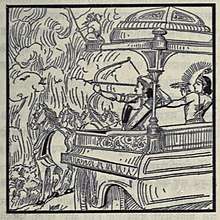
It was while at Indraprastha, the capital city of the Pandavas,[21] for the birth of Abhimanyu that Arjuna and Krishna become involved in what Alf Hiltebeitel describes as "one of the strangest scenes of the epic", this being the burning of the Khandava Forest. This story within a story has been interpreted in various ways.[20]
The essence of this part of the myth is that Arjuna and Krishna are in the forest when they are approached by a hungry person. They agree to help satisfy his hunger, at which point he reveals himself to be Agni, the god of fire. Agni's hunger can only be sated by consuming the entire forest and everything in it but his previous attempts to do this were thwarted by Indra, who is protector of the forest and sent down rains to quench the fire. The cousins agree to fend off Indra and anyone else who might interfere; to this end, Arjuna armed himself with the Gandiva bow and Krishna with his Sudarshana Chakra, weapons suitable for a fight with the gods. They then begin to destroy the forest, battling against Indra and other gods, as well as demons, animals and snakes. Once the forest has gone, after six days of fire and slaughter, Arjuna and Krishna receive thanks from Indra, who had retreated with the other gods part way through the proceedings on being commanded by a mysterious voice to step back and watch.[22]
Exile of the Pandavas
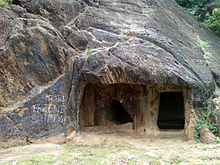
As heir to the lordship of Kurukshetra, Yudhishthira had attracted the unwelcome attention of his Kaurava cousin, Duryodhana, who sought the throne.[24] The royal consecration involved an elaborate Vedic ceremony called rajasuya which extended over several years and included the playing of a ritualised game of dice.[25] This particular game, described as "Indian literature's most notorious dice game" by Williams,[9] was rigged by Duryodhana, causing Yudhishthira to gamble and lose everything, including his kingdom and his shared wife Draupadi.[18][26] He and his brothers only obtained their freedom because Draupadi offered herself to the Kauravas in exchange. She was then humiliated by them so much that revenge for her treatment became a further motivation for the Pandavas in the rivalry with their cousins.[18] The brothers, including Arjuna, were forced into a 12-year exile, to be followed by a year living incognito if Yudhishthira was to regain his kingdom.[26]
While in this exile, Arjuna performed twelve labours. He received instruction in the use of weapons from Parashurama, the sixth avatar of Vishnu, and visited the Himalayas to get celestial weapons that he would be able to use against the Kauravas. Thereafter, he honed his battle skills with a visit to Swarga, the heaven of Indra, where he emerged victorious in a battle with the Daityas and also fought for Indra, his father, with the Gandiva.[7]
Cursed by Urvashi
During his exile Arjuna was invited to the palace of Indra, his father. An apsara named Urvashi was impressed and attracted to Arjuna's look and talent so she expresses her love in front of him. But Arjuna did not have any intentions of making love to Urvashi. Instead he called her “mother”. Because once Urvashi was the wife of King Pururavas the ancestor of Kuru dynasty. Urvashi felt insulted, and cursed Arjuna that he will be a eunuch for the rest of his life. Later on Indra’s request, Urvashi curtailed the curse to a period of one year.[27]
At Matsya Kingdom
Arjuna spent the last year of exile as a eunuch named Brihannala at King Virata’s Matsya Kingdom. He taught song and dance to the princess Uttara. Later Uttara was married to Arjuna's son Abhimanyu.[28]
Kurukshetra War
Bhagavat Gita

The Bhagavad Gita is a book within the Mahabharata that depicts a dialogue between Arjuna and Krishna immediately prior to the commencement of the Kurukshetra War between the Panadavas and Kauravas. According to Richard H. Davis,
The conversation deals with the moral propriety of the war and much else as well. The Gita begins with Arjuna in confusion and despair, dropping his weapons; it ends with Arjuna picking up his bow, all doubts resolved and ready for battle.[29]
In the war
Arjuna was a key warrior in Pandava's victory in Kurukshetra War. He killed many powerful and key warriors of Kaurava's side.
- Fall of Bhishma: On 10th day of battle, Shikhandi accompanied Arjuna on the latter's chariot and they faced Bhishma who did not fire arrows at Shikhandi. He was then felled in battle by Arjuna, pierced by innumerable arrows. With Sikhandi in front, Bhishma did not even look at that direction, Arjuna shot arrows at Bhishma, piercing his entire body.[30]
- Death of Jayadratha: Arjuna came to know that Jayadratha blocked the other four Pandavas, at entrance of Chakravyuha, due to which Abhimanyu entered alone and was killed unfairly by multiple Kaurava warriors on the 13th day of the war. Arjuna vowed to kill him the very next day before sunset, failing which he would kill himself by jumping in a fire. Arjuna killed Jayadratha on 14th day of the war.[31]
- Death of Bhagadatta: On the 12th day of the war, Arjuna killed powerful king of Pragjyotisha Bhagadatta.[32]
- Death of Karna: The much anticipated battle between Arjuna and Karna took place on the 17th day of war. The battle continued fiercely and Arjuna killed Karna by using Anjalikastra.[33]
Aranmula Parthasarathy Temple
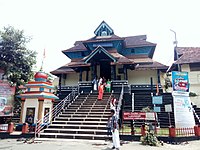
According to the legends, Arjuna built the Aranmula Parthasarathy Temple during his conquest for Ashwamedh Yagna in South India. Aranmula Parthasarathy Temple is one of the "Divya Desams", the 108 temples of Vishnu revered by the 12 poet saints, or Alwars[34] located near Aranmula, a village in Pathanamthitta District, Kerala, South India.
Death
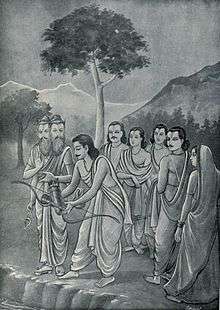
After Krishna left his mortal body, Arjuna took the citizens of Dwaraka, including 16,100 wives of Krishna, to Indraprastha. On the way, they were attacked by a group of bandits. Arjuna desisted fighting seeing the law of time.
Upon the onset of the Kali yuga and acting on the advice of Vyasa, Arjuna and other Pandavas retired, leaving the throne to their only descendant and successor Parikshit (Arjuna's grandson & Abhimanyu's son). Giving up all their belongings and ties, the Pandavas, accompanied by a dog, made their final journey of pilgrimage to the Himalayas. The listener of the Mahabharata is Janamejaya, Parikshit's son and Arjunaś great-grandson.[35]
Depictions in popular culture
Arjuna's extraordinary talents and skills have made him a common name in popular culture.
- The American astronomer Tom Gehrels named a class of asteroids with low inclination, low eccentricity and earth-like orbital period as Arjuna asteroids.[36]
- The Arjuna Award is presented every year in India to one talented sportsman in every national sport.
- Arjun is a third generation main battle tank developed for the Indian Army.[37]
- Mayilpeeli Thookkam is a ritual art of dance performed in the temples of Kerala. It is also known as Arjuna Nrithyam (‘Arjuna's dance’) as a tribute to his dancing abilities.
- Arjuna is also an Archer class Servant in the mobile game Fate/Grand Order. He is a minor antagonist in the E Pluribus Unum story chapter, where he wishes to fight Karna again.[38]
- Additionally, the protagonist in Steven Pressfield's book The Legend of Bagger Vance, Rannulph Junuh, is based in part on Arjuna (R. Junuh).[39]
In television and films
There have been a serials and films based on Arjuna's life and exploits.
- Earth Maiden Arjuna is a Japanese animated television series created by Shoji Kawamori. This series is based on Arjuna and the Mahabharata. Arjuna: Into the Another World is the soundtrack produced for the series.
- "Arjuna" is a character in Orson Scott Card's Earth Afire and Earth Awakens made in 2013 and 2014, respectively.
Television
| TV Series | Played by | Channel | Country |
|---|---|---|---|
| Mahabharat (1988 TV series) | Arjun[40] | DD National | India |
| Bharat Ek Khoj | Lalit Mohan Tiwari | ||
| Shri Krishna (1993 TV series) | Sandeep Mohan | ||
| Mahabharat Katha | Arjun | ||
| Ek Aur Mahabharat | Narendra Jha | Zee TV | |
| Jai Hanuman (1997 TV series) | Manish Khanna | DD Metro | |
| Draupadi (2001 TV series) | Rajesh Shringarpure | Sahara One | |
| Dwarkadheesh Bhagwaan Shree Krishn | Gautam Sharma | NDTV Imagine | |
| Kahaani Hamaaray Mahaabhaarat Ki | Harshad Chopda | 9X | |
| Mahabharat (2013 TV series) | Shaheer Sheikh[41] | Star Plus | |
| Dharmakshetra | Ankit Arora | EPIC | |
| Suryaputra Karn | Navi Bhangu | Sony TV | |
| Karn Sangini | Kinshuk Vaidya | Star Plus | |
| Paramavatar Shri Krishna | Ankit Bathla | &TV | |
| Radha Krishn | Kinshuk Vaidya[42] | Star Bharat |
Films
| Film | Played by |
|---|---|
| Draupadi | Prithviraj Kapoor |
| Sri Krishnarjuna Yuddhamu | Akkineni Nageswara Rao |
| Bhishma | Sobhan Babu |
| Karnan | Muthuraman |
| Mahabharat | Pradeep Kumar |
| Babruvahana | N. T. Rama Rao |
| Veerabhimanyu | Kanta Rao |
| Pandava Vanavasam | M. Balaiah |
| Sri Krishna Pandaveeyam | Sobhan Babu |
| Sri Krishnavataram | Ramakrishna |
| Daana Veera Soora Karna | Nandamuri Harikrishna |
| Babruvahana | Rajkumar |
| Kurukshetram | Krishna |
| Sampoorna Mahabharatam (1983) | Chandrakant Pandya |
| The Mahabharata | Vittorio Mezzogiorno |
| Thalapathi | Arvind Swami (Based on Arjuna's character) |
| Raajneeti | Ranbir Kapoor (Based on Arjuna's character)[43] |
| Arjun: The Warrior Prince | Yuddvir Bakolia (voice) |
| Mahabharat | Ajay Devgn (voice) |
| Mahabharat Aur Barbareek | Arjun |
| Kurukshetra | Sonu Sood[44] |
References
Notes
Citations
- "Arjuna's Many Names". The Hindu. 14 August 2018. Retrieved 21 June 2020.
- "Reasons for the names". The Hindu. 8 July 2018. ISSN 0971-751X. Retrieved 1 July 2020.
- Brockington, J. L. (1998). The Sanskrit Epics. Brill Academic. p. 26. ISBN 978-9-00410-260-6.
- Minor, Robert N. (1982). Bhagavad Gita: An Exegetical Commentary. South Asia Books. pp. l–li. ISBN 978-0-8364-0862-1.
- McGrath, Kevin (2004). The Sanskrit Hero: Karna in Epic Mahabharata. Brill Academic. pp. 19–26. ISBN 978-9-00413-729-5.
- Johnson, W. J. (2009). "Pandu". A Dictionary of Hinduism. Oxford University Press. doi:10.1093/acref/9780198610250.001.0001. ISBN 978-0-19861-025-0.
- Coulter, Charles Russell; Turner, Patricia (4 July 2013). "Arjuna". Encyclopedia of Ancient Deities. Routledge. p. 69. ISBN 978-1-13596-390-3.
- Johnson, W. J. (2009). "Pandavas". A Dictionary of Hinduism. Oxford University Press. doi:10.1093/acref/9780198610250.001.0001. ISBN 978-0-19861-025-0.
- Williams, George M. (2008). "Arjuna". Handbook of Hindu Mythology. Oxford University Press. p. 61. ISBN 978-0-19533-261-2.
- Narlikar, Amrita; Narlikar, Aruna (2014). Bargaining with a Rising India: Lessons from the Mahabharata. Oxford University Press. p. 225. ISBN 978-0-19161-205-3.
- Flood, Gavin; Martin, Charles (2012). The Bhagavad Gita: A New Translation. W. W. Norton & Company. p. 6. ISBN 978-0-39308-385-9.
- Johnson, W. J. (2009). "Bisma". A Dictionary of Hinduism. Oxford University Press. doi:10.1093/acref/9780198610250.001.0001. ISBN 978-0-19861-025-0.
- Johnson, W. J. (2009). "Drona". A Dictionary of Hinduism. Oxford University Press. doi:10.1093/acref/9780198610250.001.0001. ISBN 978-0-19861-025-0.
- Parmeshwaranand, Swami (2001). Encyclopaedic Dictionary of Purāṇas (1st ed.). New Delhi: Sarup & Sons. pp. 512–513. ISBN 978-8-17625-226-3.
- November 2, India Today Web Desk; November 2, 2017UPDATED; Ist, 2017 15:09. "ASI grants permission to excavate palace Kauravas commissioned to kill Pandavas". India Today. Retrieved 8 August 2020.CS1 maint: numeric names: authors list (link)
- Johnson, W. J. (2009). "Arjuna". A Dictionary of Hinduism. Oxford University Press. doi:10.1093/acref/9780198610250.001.0001. ISBN 978-0-19861-025-0.
- Dalal, Roshen (2010). Hinduism: An Alphabetical Guide. Penguin Books. p. 38. ISBN 978-0-14-341421-6.
- Johnson, W. J. (2009). "Draupadi". A Dictionary of Hinduism. Oxford University Press. doi:10.1093/acref/9780198610250.001.0001. ISBN 978-0-19861-025-0.
- Dalal, Roshen (2010). Hinduism: An Alphabetical Guide. Penguin Books. p. 216. ISBN 978-0-14-341421-6.
- Hiltebeitel, Alf (5 July 1990). The Ritual of Battle: Krishna in the Mahabharata. SUNY Press. p. 86. ISBN 978-0-79140-250-4.
- Singh, Upinder, ed. (2006). Delhi: Ancient History. Berghahn Books. pp. xvii–xviii. ISBN 978-8-18735-829-9.
- Framarin, Christopher G. (2014). Hinduism and Environmental Ethics: Law, Literature and Philosophy. Routledge. pp. 100–101. ISBN 978-1-31791-894-3.
- "These places in India have distinct Mahabharata, Ramayana connections". cnbctv18.com. Retrieved 1 July 2020.
- Johnson, W. J. (2009). "Yudhisthira". A Dictionary of Hinduism. Oxford University Press. doi:10.1093/acref/9780198610250.001.0001. ISBN 978-0-19861-025-0.
- Johnson, W. J. (2009). "Rajasuya". A Dictionary of Hinduism. Oxford University Press. doi:10.1093/acref/9780198610250.001.0001. ISBN 978-0-19861-025-0.
- Johnson, W. J. (2009). "Mahabharata". A Dictionary of Hinduism. Oxford University Press. doi:10.1093/acref/9780198610250.001.0001. ISBN 978-0-19861-025-0.
- Chandramouli, Anuja (15 December 2012). ARJUNA: Saga Of A Pandava Warrior-Prince. Leadstart Publishing Pvt Ltd. ISBN 978-93-81576-39-7.
- Chandramouli, Anuja (15 December 2012). ARJUNA: Saga Of A Pandava Warrior-Prince. Leadstart Publishing Pvt Ltd. ISBN 978-93-81576-39-7.
- Davis, Richard H. (2014). The "Bhagavad Gita": A Biography. Princeton University Press. p. 10. ISBN 978-0-69113-996-8.
- Chandramouli, Anuja (15 December 2012). ARJUNA: Saga Of A Pandava Warrior-Prince. Leadstart Publishing Pvt Ltd. ISBN 978-93-81576-39-7.
- Sweety, Dr Shinde (28 January 2015). Arjun: Without A Doubt. Leadstart Publishing PvtLtd. ISBN 978-93-81836-97-2.
- Barpujari, H. K. (1990). The Comprehensive History of Assam: Ancient period. Publication Board, Assam.
- Chandramouli, Anuja (15 December 2012). ARJUNA: Saga Of A Pandava Warrior-Prince. Leadstart Publishing Pvt Ltd. ISBN 978-93-81576-39-7.
- 108 Vaishnavite Divya Desams: Divya desams in Malai Nadu and Vada Nadu. M. S. Ramesh, Tirumalai-Tirupati Devasthanam.
- Bowker, John (2000). The Concise Oxford Dictionary of World Religions. Oxford: Oxford University Press. doi:10.1093/acref/9780192800947.001.0001. ISBN 9780192800947.
- de la Fuente Marcos, C.; de la Fuente Marcos, R. (12 February 2015). "Geometric characterization of the Arjuna orbital domain". Astronomische Nachrichten. 336 (1): 5–22. arXiv:1410.4104. Bibcode:2015AN....336....5D. doi:10.1002/asna.201412133.
- "Arjun Main Battle Tank". Army Technology. Archived from the original on 10 December 2019. Retrieved 19 June 2020.
- Lynn, David. "Archers in the Fate Universe Who ACTUALLY Use Bows". Crunchyroll. Retrieved 21 June 2020.
- Rosen, Steven (30 May 2002). Gita on the Green: The Mystical Tradition Behind Bagger Vance – Steven Rosen – Google Boeken. ISBN 9780826413659. Retrieved 9 August 2013.
- "Mahabharat's Arjun Firoz Khan Says Changing His Name Gave Him Everything He'd Dreamed of". News18. 27 April 2020. Retrieved 19 June 2020.
- DelhiMay 1, Shweta Keshri New; May 1, 2020UPDATED; Ist, 2020 20:12. "Shaheer Sheikh on Mahabharat: It was like boys' hostel, made some amazing friends". India Today. Retrieved 19 June 2020.CS1 maint: numeric names: authors list (link)
- "Kinshuk Vaidya enters RadhaKrishn as Arjun". India Today. Retrieved 8 July 2020.
- World, Republic. "Ranbir Kapoor's 'Raajneeti' is a modern-day retelling of Mahabharata; read to know". Republic World. Retrieved 19 June 2020.
- "Sonu Sood to play Arjun in Kannada film Kurukshetra". The Indian Express. 11 July 2019. Retrieved 19 June 2020.
Further reading
- McGrath, Kevin (2016). Arjuna Pandava: The Double Hero in Epic Mahabharata. Orient Blackswan. ISBN 978-8-12506-309-4.
External links


- Arjuna at Encyclopædia Britannica
